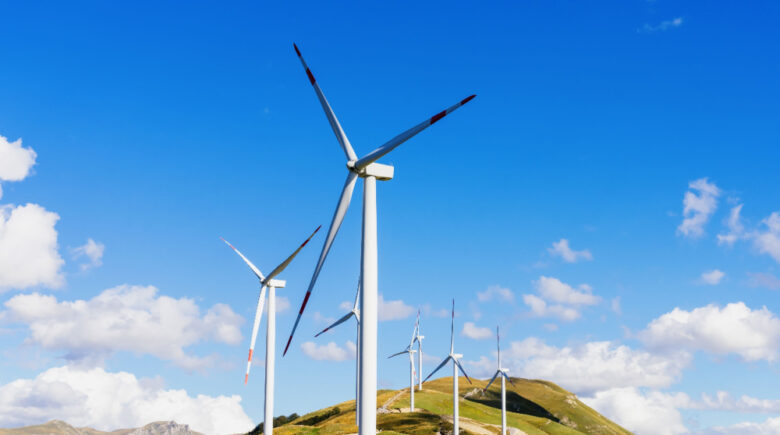Wind energy is widely recognized as one of the most promising renewable energy sources, transforming how we generate and use electricity. As the world faces the urgent need to transition from fossil fuels to renewable energy, wind power is gaining attention as a viable solution. This article delves into wind energy, its advantages and disadvantages, and its role in building a sustainable future.
The Basics of Wind Energy
Wind energy is generated by using wind turbines to convert the kinetic energy of the wind into mechanical energy. These turbines consist of blades that capture the wind’s energy, causing the rotor to turn. This mechanical movement is then transformed into electrical energy by a generator. While the process is relatively straightforward, it is highly effective, making wind energy one of the most important and widely used renewable energy sources today.
The Growth of Wind Energy
Wind energy generation saw significant growth in 2022, reaching 2,106 TWh, with a record increase of 265 TWh (14%). This made it the second fastest-growing renewable energy source after solar power. However, to meet the goal of net-zero emissions by 2050, wind energy generation needs to reach approximately 7,400 TWh by 2030, requiring an annual growth rate of 17%.
To achieve this, annual capacity additions need to increase from 75 GW in 2022 to 350 GW by 2030. Achieving this ambitious target will require substantial efforts from both policymakers and the private sector. The greatest potential lies in streamlining onshore wind permitting processes and reducing the cost of offshore wind projects. This growth is driven by technological innovations, decreasing implementation costs, and increasing awareness of climate change impacts.
Environmental Benefits of Wind Energy
One of the key advantages of wind energy is its minimal environmental impact. Unlike fossil fuels, wind power generation produces no direct greenhouse gas emissions, making it a crucial tool in the fight against climate change. Wind turbines also require significantly less land than other energy sources, preserving space for natural habitats and agriculture.
Economic Advantages
Wind energy offers substantial economic benefits as well. The industry creates jobs in manufacturing, installation, maintenance, and research. According to the International Renewable Energy Agency (IRENA), the wind sector employed over 1.2 million people globally in 2019. Additionally, wind power can reduce reliance on imported fuels, enhance energy security, and help stabilize energy prices.
Technological Innovations
Recent advancements in wind energy technology have greatly improved its efficiency and cost-effectiveness. Innovations in turbine size, floating wind farms, and advanced materials have increased capacity factors and lowered the levelized cost of electricity (LCOE) from wind power. These developments are positioning wind energy as a competitive and sustainable energy source compared to conventional power options.
Challenges and Solutions
Despite its many advantages, wind energy does face challenges. One major concern is its intermittent nature; because the wind doesn’t blow constantly, energy production can be inconsistent. However, advancements in energy storage technologies, such as batteries and pumped hydro storage, are helping balance supply and demand. Additionally, integrating wind energy with other power systems requires the adoption of smart devices to manage fluctuating supply.
Another challenge is the impact of wind turbines on wildlife, particularly birds and bats. Efforts to mitigate these effects include redesigning turbine blades and implementing technologies to reduce wildlife collisions. Community opposition, often due to concerns about noise and visual impact, is another obstacle. Involving local communities in the planning and decision-making processes can help address these concerns and foster greater acceptance.
The Role of Offshore Wind Farms
Offshore wind farms represent a significant opportunity for expanding wind energy capacity. These farms are situated in bodies of water, where wind speeds are generally stronger and more consistent than on land. Europe, particularly the UK and Denmark, has led the way in offshore wind development, providing a model for other regions to follow.
Wind Energy and the Future
As wind energy technology continues to evolve, more individuals and businesses are investing in this renewable resource. Governments around the world are increasingly embracing wind power as a key component of their efforts to combat climate change and transition to a greener energy system. For example, the European Union has set a target of achieving 60 GW of offshore wind capacity by 2030, reflecting a strong commitment to expanding wind energy use.
Conclusion
Wind energy stands out as one of the most promising and rapidly growing renewable energy sources available today. As technology continues to advance and global support for renewable energy strengthens, wind power will play an increasingly vital role in the future energy mix. By seizing the opportunities and addressing the challenges, wind energy has the potential to significantly reduce greenhouse gas emissions, generate economic benefits, and enhance energy security. Embracing wind energy is not only an environmental imperative but also an economic and social priority that can help shape a cleaner, greener world. The future of wind energy is bright, and it will be instrumental in guiding us toward a sustainable future.
Wind energy is widely recognized as one of the most promising renewable energy sources, transforming how we generate and use electricity. As the world faces the urgent need to transition from fossil fuels to renewable energy, wind power is gaining attention as a viable solution. This article delves into wind energy, its advantages and disadvantages, and its role in building a sustainable future.
The Basics of Wind Energy
Wind energy is generated by using wind turbines to convert the kinetic energy of the wind into mechanical energy. These turbines consist of blades that capture the wind’s energy, causing the rotor to turn. This mechanical movement is then transformed into electrical energy by a generator. While the process is relatively straightforward, it is highly effective, making wind energy one of the most important and widely used renewable energy sources today.
The Growth of Wind Energy
Wind energy generation saw significant growth in 2022, reaching 2,106 TWh, with a record increase of 265 TWh (14%). This made it the second fastest-growing renewable energy source after solar power. However, to meet the goal of net-zero emissions by 2050, wind energy generation needs to reach approximately 7,400 TWh by 2030, requiring an annual growth rate of 17%.
To achieve this, annual capacity additions need to increase from 75 GW in 2022 to 350 GW by 2030. Achieving this ambitious target will require substantial efforts from both policymakers and the private sector. The greatest potential lies in streamlining onshore wind permitting processes and reducing the cost of offshore wind projects. This growth is driven by technological innovations, decreasing implementation costs, and increasing awareness of climate change impacts.
Environmental Benefits of Wind Energy
One of the key advantages of wind energy is its minimal environmental impact. Unlike fossil fuels, wind power generation produces no direct greenhouse gas emissions, making it a crucial tool in the fight against climate change. Wind turbines also require significantly less land than other energy sources, preserving space for natural habitats and agriculture.
Economic Advantages
Wind energy offers substantial economic benefits as well. The industry creates jobs in manufacturing, installation, maintenance, and research. According to the International Renewable Energy Agency (IRENA), the wind sector employed over 1.2 million people globally in 2019. Additionally, wind power can reduce reliance on imported fuels, enhance energy security, and help stabilize energy prices.
Technological Innovations
Recent advancements in wind energy technology have greatly improved its efficiency and cost-effectiveness. Innovations in turbine size, floating wind farms, and advanced materials have increased capacity factors and lowered the levelized cost of electricity (LCOE) from wind power. These developments are positioning wind energy as a competitive and sustainable energy source compared to conventional power options.
Challenges and Solutions
Despite its many advantages, wind energy does face challenges. One major concern is its intermittent nature; because the wind doesn’t blow constantly, energy production can be inconsistent. However, advancements in energy storage technologies, such as batteries and pumped hydro storage, are helping balance supply and demand. Additionally, integrating wind energy with other power systems requires the adoption of smart devices to manage fluctuating supply.
Another challenge is the impact of wind turbines on wildlife, particularly birds and bats. Efforts to mitigate these effects include redesigning turbine blades and implementing technologies to reduce wildlife collisions. Community opposition, often due to concerns about noise and visual impact, is another obstacle. Involving local communities in the planning and decision-making processes can help address these concerns and foster greater acceptance.
The Role of Offshore Wind Farms
Offshore wind farms represent a significant opportunity for expanding wind energy capacity. These farms are situated in bodies of water, where wind speeds are generally stronger and more consistent than on land. Europe, particularly the UK and Denmark, has led the way in offshore wind development, providing a model for other regions to follow.
Wind Energy and the Future
As wind energy technology continues to evolve, more individuals and businesses are investing in this renewable resource. Governments around the world are increasingly embracing wind power as a key component of their efforts to combat climate change and transition to a greener energy system. For example, the European Union has set a target of achieving 60 GW of offshore wind capacity by 2030, reflecting a strong commitment to expanding wind energy use.
Conclusion
Wind energy stands out as one of the most promising and rapidly growing renewable energy sources available today. As technology continues to advance and global support for renewable energy strengthens, wind power will play an increasingly vital role in the future energy mix. By seizing the opportunities and addressing the challenges, wind energy has the potential to significantly reduce greenhouse gas emissions, generate economic benefits, and enhance energy security. Embracing wind energy is not only an environmental imperative but also an economic and social priority that can help shape a cleaner, greener world. The future of wind energy is bright, and it will be instrumental in guiding us toward a sustainable future.




